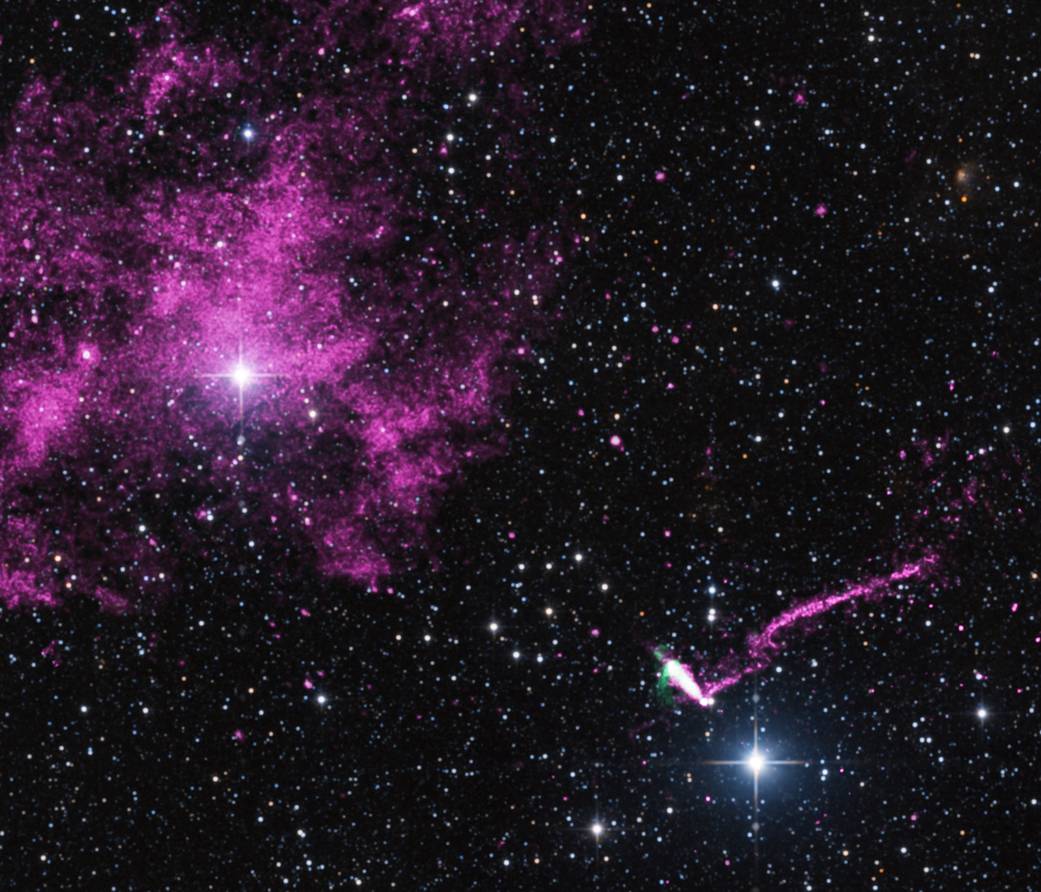An extraordinary jet trailing behind a runaway pulsar is seen in this composite image that contains data from NASA’s Chandra X-ray Observatory (purple), radio data from the Australia Compact Telescope Array (green), and optical data from the 2MASS survey (red, green, and blue). The pulsar – a spinning neutron star – and its tail are found in the lower right of this image. The tail stretches for 37 light years , making it the longest jet ever seen from an object in the Milky Way galaxy, as described in our press release.
The pulsar, originally discovered by ESA’s INTEGRAL satellite, is called IGR J1104-6103 and is moving away from the center of the supernova remnant where it was born at a speed between 2.5 million and 5 million miles per hour. This supersonic pace makes IGR J1104-6103 one of the fastest moving pulsars ever observed.
A massive star ran out of fuel and collapsed to form the pulsar along with the supernova remnant, the debris field seen as the large purple structure in the upper left of the image. The supernova remnant (known as SNR MSH 11-61A) is elongated along the top-right to bottom left direction, roughly in line with the tail’s direction. These features and the high speed of the pulsar suggest that jets could have played an important role in the supernova explosion that formed IGR J1104-6103.
In addition to its exceptional length, the tail behind IGR J1104-6103 has other interesting characteristics. For example, there is a distinct corkscrew pattern in the jet. This pattern suggests that the pulsar is wobbling like a top as it spins, while shooting off the jet of particles.
Another interesting feature of this image is a structure called a pulsar wind nebula (PWN), a cocoon of high-energy particles that enshrouds the pulsar and produces a comet-like tail behind it. Astronomers had seen the PWN in previous observations, but the new Chandra and ATCA data show that the PWN is almost perpendicular to the direction of the jet. This is intriguing because usually the pulsar’s direction of motion, its jet, and its PWN are aligned with one another.
One possibility requires an extremely fast rotation speed for the iron core of the star that exploded as the supernova. A problem with this scenario is that such fast speeds are not commonly expected to be achievable.
A paper, led by Lucia Pavan of the University of Geneva in Switzerland, describing these results appears in the February 18th issue of the journal Astronomy & Astrophysics and is also available online. Other authors include Pol Bordas (University of Tuebingen in Germany), Gerd Puehlhofer (Univ. of Tuebingen), Miroslav Filipovic (University of Western Sydney in Australia), A. De Horta (Univ. of Western Sydney), A. O’Brien (Univ. of Western Sydney), M. Balbo (Univ. of Geneva), R. Walter (Univ. of Geneva), E. Bozzo (Univ. of Geneva), C. Ferrigno (Univ. of Geneva), E. Crawford (Univ. of Western Sydney), and L. Stella (INAF).
Image credit: X-ray: NASA/CXC/ISDC/L.Pavan et al, Radio: CSIRO/ATNF/ATCA Optical: 2MASS/UMass/IPAC-Caltech/NASA/NSF


























